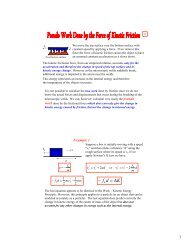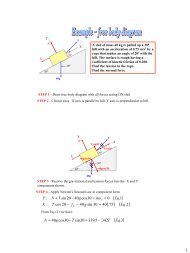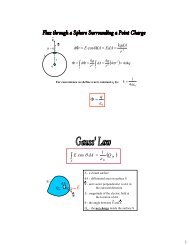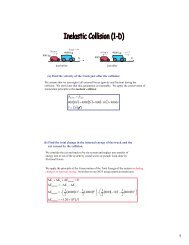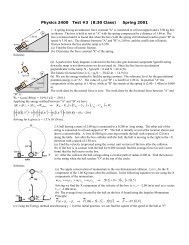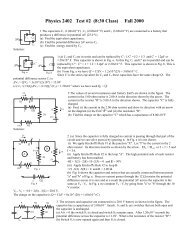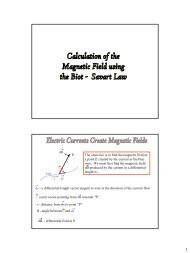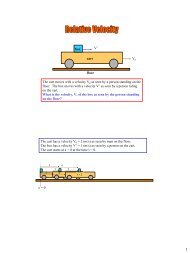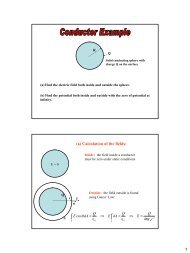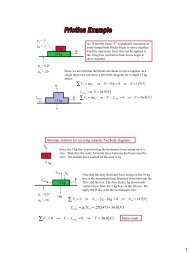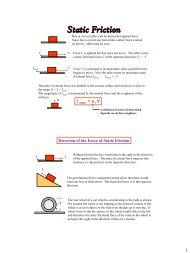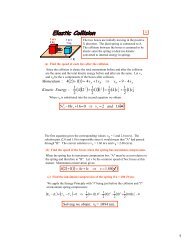Friction Laws and Work-Energy with Non Conservative Forces
Friction Laws and Work-Energy with Non Conservative Forces
Friction Laws and Work-Energy with Non Conservative Forces
Create successful ePaper yourself
Turn your PDF publications into a flip-book with our unique Google optimized e-Paper software.
well as any kinetic friction in the wheel bearings. Since therolling frictional force is very small, we should minimize thecontribution of other forces, such as gravity, that would tendto obscure the rolling frictional force. Ideally the plank shouldbe level to eliminate the gravitational force component.However, if the plank is not perfectly level, a smallgravitational force component will act on the cart in adirection parallel to the plank. We remove the possibleinfluence of gravity by measuring the acceleration of the cartfor motion in both directions. The cart is placed on the plankalong <strong>with</strong> the motion sensor <strong>and</strong> given a gentle push. Theacceleration is measured a few times. Then the cart is pushedin the opposite direction <strong>and</strong> its acceleration measured. Fromthese values we can obtain the coefficient of rolling frictionfor the cart.The cart is shown in Fig. 4. We have assumed that the tabletop may be tilted by a very small angle θ from the horizontal.When the cart is given a gentle push to the right we let itsacceleration be “a r ” <strong>and</strong> we choose the positive direction to betowards the right. The gravitational force component“mgsinθ” is smaller than the frictional force <strong>and</strong> the cart slowsdown even though it may be going down a slight hill. Weapply Newton’s II Law to the free body diagram shown:() 9FN= mg cosθ...mg sinθ− f = marollr...( 10)When the cart is pushed to the left we take the positivedirection to the left <strong>and</strong> both the frictional <strong>and</strong> gravitationalforces slow the cart down:− mg sinθ− f roll= mal...( 11)We solve equations (10) <strong>and</strong> (11) for the force of rollingfriction:froll− m ar=2( + a )l...( 12)• Place the motion sensor to the left of the cart <strong>and</strong> give thecart a gentle push to the right. Use the motion sensor to recordits velocity for three seconds. Do a linear fit to find theacceleration of the cart. Obtain at least three measurements ofthe acceleration “a r ” <strong>and</strong> find the average value. Note that thisvalue should be negative.• Place the motion sensor to the right of the cart <strong>and</strong> push thecart gently to the left <strong>and</strong> obtain at least three values of theacceleration “a l ”. Find the average which should also benegative.• Compute the coefficient of rolling friction of the cart usingEq. 13.How does the coefficient of rolling friction of the cartcompare <strong>with</strong> the coefficient of kinetic friction of the slidingblock?Check List: Minimal Requirements for Lab Notebook ReportThe significance of each graph must be discussed <strong>and</strong> the fitted values(such as the intercept <strong>and</strong> slope) must be compared <strong>with</strong> model valueswhen possible.Part A: Excel Data Table <strong>with</strong> masses used, calculated normal force,calculated frictional force <strong>and</strong> the coefficient of kinetic friction. Plot of kinetic frictional force versus the normal force <strong>with</strong> a linearfit through the origin. The % difference between the coefficient ofkinetic friction from the graph <strong>and</strong> the mean table value. Copy of one Data Studio plot of speed versus time.Part B: A copy of a few rows of your excel sheet displaying the distance,speed <strong>and</strong> energies. Plot of the kinetic, potential <strong>and</strong> total energy versus distance <strong>with</strong> alinear fit of the total energy curve. The value of the coefficient of kinetic friction obtained from the fit.Part C: Data Studio plot of the force applied by the force sensor versus time. The maximum force of static friction <strong>and</strong> the mean force of kineticfriction obtained from this plot. The coefficients of static <strong>and</strong> kinetic friction found from the abovefrictional forces. Compare the mean frictional force found in C <strong>with</strong> mean value foundin A <strong>and</strong> the value obtained in B. Discussion of these results.The coefficient of rolling friction is:μrollf=FrollN( a + a ) − ( a + a )−r lr= ≈2gcosθ2gl...( 13)Part D: Excel data table for measured accelerations <strong>and</strong> the computed valuefor the coefficient of rolling friction. Discussion.ConclusionsSince θ is a very small angle its cosine is very close to one.



